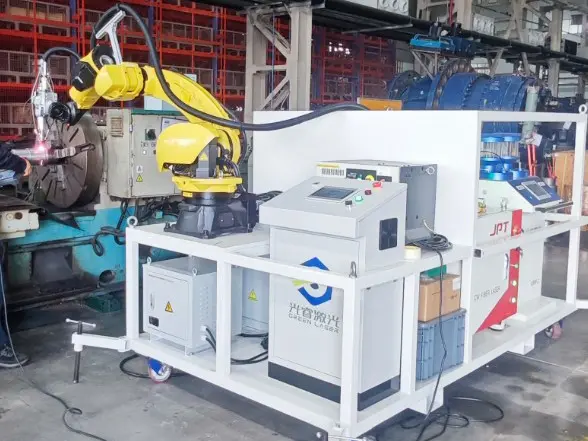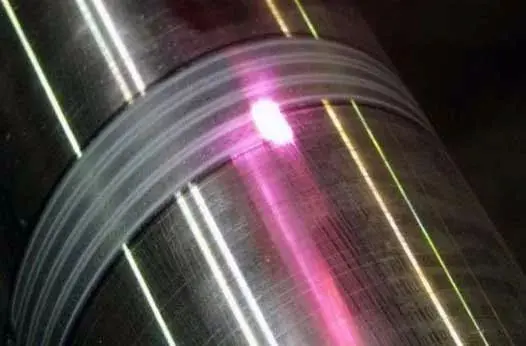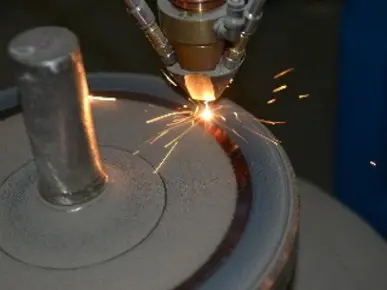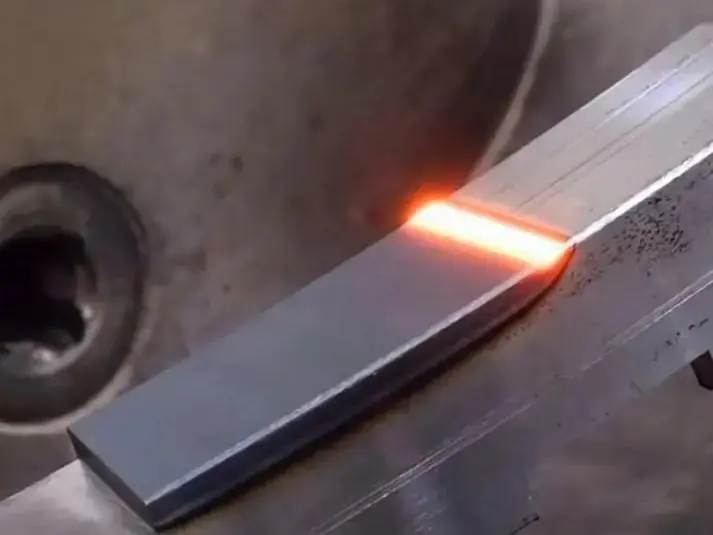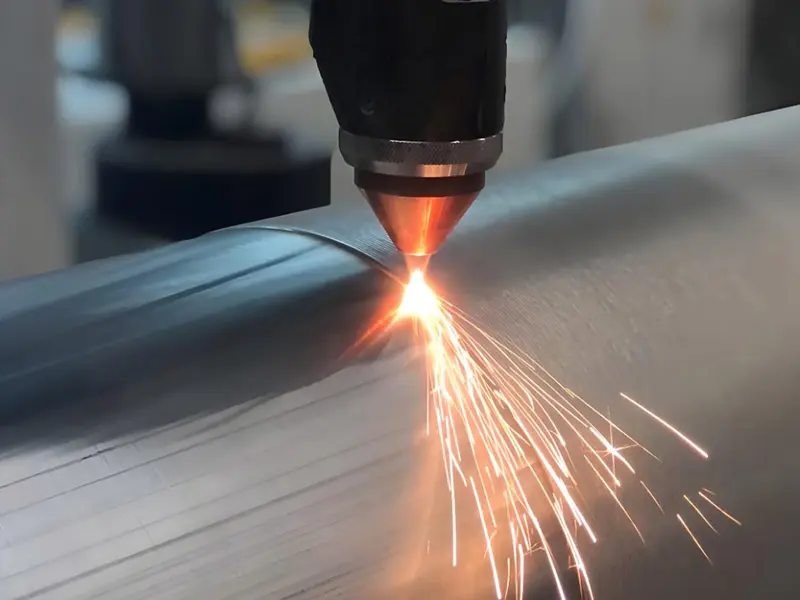Analysis of material types and characteristics suitable for laser quenching technology
I. Ferrous metal materials (currently the most mainstream application)
1. Medium and high carbon steel (carbon content 0.3%~0.8%), typical materials:
45 steel (high-quality medium-carbon structural steel), designated as S45C in JIS standards, ASTM 1045/080M46, and DIN C45, is a premium carbon structural steel with the following chemical composition: 0.42-0.50% carbon (C), 0.17-0.37% silicon (Si), 0.50-0.80% manganese (Mn), and ≤0.25% chromium (Cr). This versatile material demonstrates excellent cold/hot workability, superior mechanical properties, cost-effectiveness, and wide availability, making it widely used in industrial applications. However, its primary limitation lies in low hardenability, rendering it unsuitable for manufacturing components requiring large cross-sectional dimensions or high precision standards.
T8 steel: A eutectoid carbon tool steel that exhibits high hardness and wear resistance after quenching and tempering, though it has limitations including low hot hardenability, poor hardenability, and susceptibility to overheating deformation during machining. This material complies with the GB/T 1298 series standards, containing carbon content between 0.75% and 0.84%, making it suitable for manufacturing simple-shaped cold-forming dies and cutting tools. The quenching process requires water cooling at 780-800℃°C, while tempering above 250℃°C ensures dimensional stability. However, it is not recommended for applications requiring impact load resistance.
65Mn Steel: A spring steel product with high strength after heat treatment and cold drawing hardening, offering good flexibility and plasticity. Under identical surface conditions and full hardening, its fatigue limit matches that of five-color alloy springs. However, due to poor hardenability, it is mainly used for small-sized springs such as pressure-adjusting/speed-regulating springs, force-measuring springs, general mechanical circular/rectangular helical springs, or wire-drawn steel springs for small machinery. Hardening Effect: Surface hardness reaches 55-65 HRC with a hardened layer depth 0.2~1.5mm, featuring uniform martensitic structure and significantly improved wear resistance (e.g., 45 steel's wear life increases 4-6 times after quenching). Suitable for gears, pins, and shaft components. Mechanism: Sufficient carbon content forms abundant martensite, which undergoes complete austenitization during rapid laser heating and achieves full phase transformation through self-cooling quenching.

2. Alloy structural steel (add Cr, Ni, Mo and other elements), typical materials:
40Cr: (40Cr falls under the category of "alloy structural steel" as defined in GB3077. This steel contains 0.37%-0.44% carbon, slightly lower than 45 steel, with comparable Si and Mn content. It contains 0.80%-1.10% Cr. In hot-rolled applications, this 1% Cr content is essentially ineffective, as both grades demonstrate similar mechanical properties. Given that 40Cr costs about half as much as 45 steel, economic considerations often lead to using 45 steel instead when possible.
35CrMo: 35CrMo is a specification code for alloy structural steel (alloy quenched and tempered steel), corresponding to German standard 1.7220, British standard 708A37, French standard 35CD4, etc., with compliance to GB/T 3077-2015. It has a carbon equivalent of 0.72%, poor weldability requiring preheating measures. This steel exhibits high static strength and impact toughness, with tensile strength ≥985MPa and yield strength ≥835MPa, capable of withstanding long-term operating temperatures up to 500℃. It is suitable for manufacturing high-load mechanical components such as gearboxes, crankshafts, connecting rods, and steam turbine spindles in rolling mills.
20CrMnTi: A carburized steel with a carbon content of 0.17%-0.24%, commonly used in automotive manufacturing for transmission gears. As a medium-hardening carburized steel (Cr-Mn-Ti), it demonstrates exceptional hardenability while maintaining high low-temperature impact toughness. Specifically engineered for surface carburization hardening, this steel exhibits excellent machinability with minimal deformation and outstanding fatigue resistance. Its primary applications include manufacturing shaft components, piston parts, and specialized components for automobiles and aircraft.
Quenching effect: hardness can reach 60~70 HRC, hardened layer depth 0.3~2mm, alloy elements improve the hardenability and corrosion resistance (such as 35CrMo gear after quenching fatigue strength increased by 30%).
Note: The high alloy content may reduce the laser absorption rate, so it is necessary to enhance the energy absorption efficiency through blackening treatment (such as phosphating and coating).
3. Cast iron (gray cast iron, ductile cast iron), typical materials:
HT300: is a pearlite type of high strength gray cast iron, implement the national standard GB 9439-88, its name "HT" represents gray cast iron, "300" indicates that the minimum tensile strength of a 30mm diameter test rod is 300MPa.
QT600-3: QT600-3 is pearlitic body ductile iron, with medium and high strength, medium toughness and plasticity, high comprehensive performance, good wear resistance and vibration damping, good casting process characteristics. It can change its properties through various heat treatments.
Quenching effect: the surface hardness can reach 45~55 HRC, the hardened layer depth 0.1~0.8mm, and the martensite + residual austenite structure is formed around the graphite phase, which enhances the ability of anti-grinding (for example, the friction coefficient of machine tool guide rail after quenching is reduced by 20%).
II. Non-ferrous metals and their alloys (emerging application fields)
1. Titanium alloy (Ti-6Al-4V, etc.)
Titanium alloy refers to a variety of alloys made with titanium and other metals. Titanium is an important structural metal developed in the 1950s, titanium alloy strength, corrosion resistance, high heat resistance.
Hardening characteristics: The laser heating promotes the formation of supersaturated martensite on the surface, and the hardness is increased from 300 HV to 500~600 HV, while maintaining good toughness (suitable for aero-engine blade reinforcement).
Technical difficulty: titanium alloy has high laser reflectivity (about 70%), so surface pretreatment (such as sandblasting) or ultraviolet laser (wavelength 355nm, reflectivity below 30%) should be used.
2. Aluminum alloy (2xxx series, 7xxx series)
This is an aluminum-based alloy material containing added elements such as copper, silicon, magnesium, zinc, and manganese. Through element ratio adjustments, it forms the 1XXX to 8XXX series covering industrial pure aluminum and aluminum-copper alloys. Its state code system is based on five fundamental states including F (free machining) and O (annealing), with detailed codes like T6 enabling precise control of strength and corrosion resistance properties.
Quenching mechanism: The solid solution strengthening is achieved by rapid heating of laser, and the metastable precipitated phase is formed after self-cooling (for example, the hardness of 7075 aluminum alloy increases from 150 HV to 220 HV after quenching).
Application limitations: aluminum alloy has strong thermal conductivity (thermal conductivity is about 200 W/m K), high power laser (≥2 kW) is required to ensure heating efficiency, and it is easy to produce thermal stress deformation.
3. Tin alloys (brass, bronze)
This is an alloy composed of pure copper with one or more additional elements. Applications: Surface hardening of wear-resistant components (e.g., bearings, valves). After laser quenching, the surface forms a nanocrystalline structure, increasing hardness by 15% to 30%. However, heating temperature must be controlled to prevent softening of the copper matrix.
III. Special Functional Materials
1. Powder Metallurgy Materials (e.g., iron-based and copper-based powder metallurgical components) Advantages: The porous structure can store lubricating oil, with the surface becoming denser after laser quenching. Hardness increases from 20-30 HRC to 50-55 HRC, making them suitable for self-lubricating bearings.
2. Surface Coating Materials (e.g., thermal spray coatings and cladding layers) Typical Applications: After laser quenching of WC-Co coatings sprayed on carbon steel surfaces, a "martensite matrix + cemented carbide phase" composite structure is formed, achieving a hardness exceeding 1000 HV. These materials are used in wear-resistant components of mining machinery.
IV. Materials unsuitable for laser quenching
Low-carbon steel (carbon content <0.3%): Due to insufficient carbon content, the martensitic transformation is minimal, resulting in poor hardening effects (hardness increase <10 HRC). This makes it more suitable for carburizing and quenching processes.
Pure austenitic stainless steel (e.g., 316L): Lacks martensitic transformation capability. Laser heating only causes work hardening with limited hardness improvement (approximately 15% -20%).
Polymer materials (plastics, rubber): Laser heating tends to cause melting or decomposition, requiring alternative surface treatment techniques such as plasma treatment.
V. Summary
Laser quenching technology is primarily applicable to medium-high carbon steels, alloy structural steels, and cast iron. In recent years, its applications have expanded to non-ferrous metals such as titanium alloys and aluminum alloys. Material selection requires comprehensive consideration of laser absorption rates, thermal conductivity, and phase transition characteristics. Process parameter optimization (e.g., power and scanning speed) combined with surface pretreatments (blackening and roughening) can enhance quenching effectiveness. For non-quenching strengthening materials like low-carbon steels and pure austenitic stainless steels, composite processes (e.g., laser quenching combined with surface alloying) or alternative surface treatment techniques are recommended.


